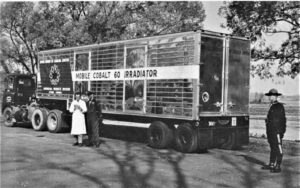The 25 October, 1961, issue of the North Renfrew Times featured a photograph of a mobile unit developed at the Commercial Products Division (CPD) of AECL for the irradiation of potatoes to prevent them from sprouting. The unit, mounted on a tractor-trailer and based around a strong cobalt-60 (Co-60) source surrounded by a 20-ton, lead-lined shielding drum, was about to venture on the highways of much of eastern Canada during potato harvest season. A publicity photograph issued later showed the unit with an RCMP officer standing smartly nearby.
During the 1960’s, food irradiation became a very promising field with work being done with Co-60 at CPD in close cooperation with the USA Army lab at Natick, MA, where irradiations were done with 10 MeV electron beams. The Canadian effort was aimed mostly at preventing sprouting while the Natick Labs effort was aimed at long-term preservation both of army rations and food for space flights. Much of the food consumed by astronauts on the Apollo space missions was electron-beam irradiated at Natick.
While soldiers usually have little say on their rations and the astronauts were very happy to use every possible means to prevent food-borne illness on their extended flights, irradiated foods have not been readily accepted by the public. Where are we now, 65 years after these first attempts?
The web tells us that food irradiation is now permitted in over 60 countries with about 500,000 metric tons being treated annually. There is wide variation in the regulations as to what can be irradiated and how. For most countries in the European Union the list of products is restricted to spices, herbs and seasonings. Brazil, on the other hand, permits all foods to be irradiated. In Canada the following irradiated foods: (1) potatoes, (2) onions, (3) wheat, flour, whole wheat flour, and (4) whole or ground spices and dehydrated seasoning preparations, are currently permitted for sale. One wonders if the non-sprouting garlic from China sold locally may be slipping under the radar of the regulators.
The National Aeronautical Space Agency (NASA) currently has dispensation from the U.S. Food and Drug Administration (FDA) to use radiation-sterilized beef steaks on space missions, but the prospects of long space journeys to Mars and elsewhere have rekindled interest in the wider use of the irradiation process to extend food shelf-life. The increased use in situations such as these may lead to greater public acceptance of radiation-treated food, lead to increased food shelf-life, and decrease the food waste currently seen, at least in the richer part of the world.
To learn more about food irradiation, readers are invited to visit and to browse the extensive library at the Canadian Nuclear Heritage Museum. To arrange a visit, send an email to info@nuclearheritage.com.

